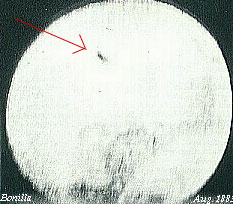Bonilla observation on:
[Wikipedia]
[Google]
[Amazon]
 On August 12, 1883, the
On August 12, 1883, the
 On August 12, 1883, the
On August 12, 1883, the astronomer
An astronomer is a scientist in the field of astronomy who focuses their studies on a specific question or field outside the scope of Earth. They observe astronomical objects such as stars, planets, moons, comets and galaxies – in either ...
José Bonilla reported that he saw more than 300 dark, unidentified objects crossing before the Sun while observing sunspot
Sunspots are phenomena on the Sun's photosphere that appear as temporary spots that are darker than the surrounding areas. They are regions of reduced surface temperature caused by concentrations of magnetic flux that inhibit convection. S ...
activity at Zacatecas Observatory in Mexico. He was able to take several photographs, exposing wet plates at 1/100 second. Bonilla's photos have been credited with being some of the earliest photos of unidentified flying object
An unidentified flying object (UFO), more recently renamed by US officials as a UAP (unidentified aerial phenomenon), is any perceived aerial phenomenon that cannot be immediately identified or explained. On investigation, most UFOs are Ide ...
s. The objects were subsequently identified as high-flying geese.
In 2011, researchers from the National Autonomous University of Mexico
The National Autonomous University of Mexico ( es, Universidad Nacional Autónoma de México, UNAM) is a public research university in Mexico. It is consistently ranked as one of the best universities in Latin America, where it's also the bigges ...
suggested that the unidentified objects may have been fragments of an estimated billion-ton comet
A comet is an icy, small Solar System body that, when passing close to the Sun, warms and begins to release gases, a process that is called outgassing. This produces a visible atmosphere or coma, and sometimes also a tail. These phenomena ...
passing within a few hundred kilometers of Earth.
Similar comet fragments may have caused the Younger Dryas
The Younger Dryas (c. 12,900 to 11,700 years BP) was a return to glacial conditions which temporarily reversed the gradual climatic warming after the Last Glacial Maximum (LGM, c. 27,000 to 20,000 years BP). The Younger Dryas was the last stag ...
event, around 12,900 years ago.
References
{{DEFAULTSORT:Bonilla Observation UFO sightings Comets 1883 in Mexico Zacatecas Historical events in Mexico